Art education plays an important part in an all-round development of young children. Friedrich Froebel, originator of the ‘kindergarten system’, believed that young children should engage in their own creative processes as well as appreciating others’ artistic creation as early as possible. For him, art education was of great importance because it not only taps into the potential of young children, but also helps them to develop in a comprehensive manner.
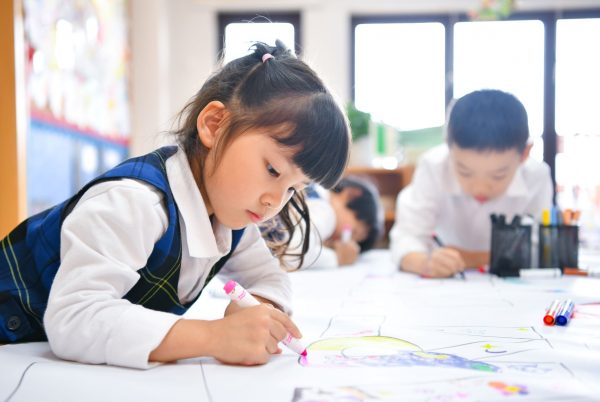 Childhood marks the initial development period of children’s artistic talent, when we can get twice the results with half the effort if we start with the right art education provision delivered in the right way.
Cultivates young children’s imagination, discernment and creativity
Childhood marks the initial development period of children’s artistic talent, when we can get twice the results with half the effort if we start with the right art education provision delivered in the right way.
Cultivates young children’s imagination, discernment and creativity
Artistic creation helps build children’s intuition, discernment and spatial imagination abilities, which complements their abstract logical thinking and contributes to their overall intelligence development.
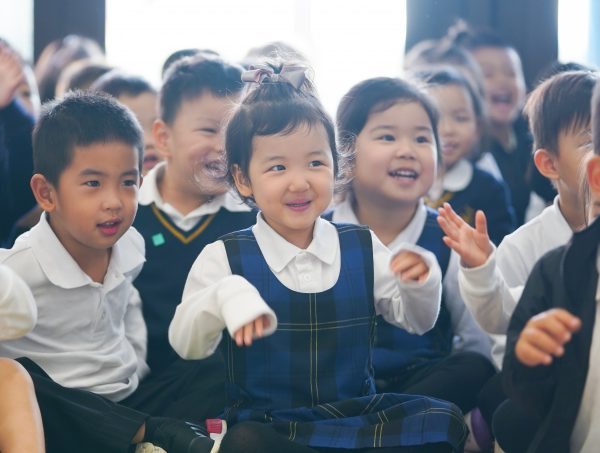
It also drives them to imagine freely and boldly. Generally, we hardly set any limitations during their creative activities, as we intend to give them as much freedom as possible to utilise their imagination and innate creativity. Thus, children can represent whatever they visualise via different artistic media.
Develops young children’s personality
When children get involved in artistic creation, whether they use clay to make a model, a crayon to draw or recycled materials to create a collage, they will achieve a sense of personal satisfaction. This is because they are given the chance to choose their own materials and determine exactly how they wish their art to work. This process builds confidence and artistic flair.
When children participate in art activities together with their peers, they are able to communicate with each other and give their feedback while practising their social skills, such as sharing, negotiating and arranging.
Training young children’s hand-eye-brain coordination
In the process of artistic creation, young children’s fine and gross motor skills are developed, boosting their coordination and strength. By manipulating artistic tools and materials, flexibility and control of their motor skills are improved, aiding young children to develop their hand-eye coordination as well as enhancing their ability to use tools confidently.
Strengthen young children’s brain coordination
According to American scientist prof. Roger Sperry’s research, functions of cerebral hemispheres are highly specialised and each is independent yet interconnected with the other.
The right cerebral hemisphere dominates imaginal thinking tasks that are often used in artistic creation. To this end, art education helps to strengthen the brain’s coordination abilities while developing the potential of the right cerebral hemisphere.
Meanwhile, it also promotes the language function of the left cerebral hemisphere. Through artistic creation, various abilities of young children can be developed and that is why art education is critically important for cultivating the ‘whole child’.
Hiba Nursery Art Festival
During arts week, Hiba Academy Shanghai pupils took part in an interesting activity based on the theme of ‘four seasons’. Although pupils have had many daily opportunities to create art works, this was the first time that they joined in a whole-nursery art project.
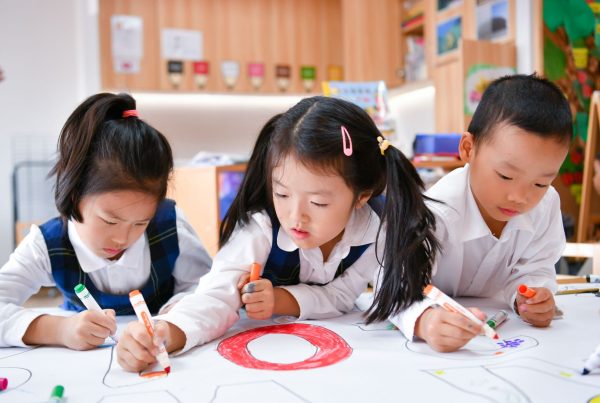
For young children, artistic creation is a sensory exploration activity. They like to paint on paper with different colours to see how a colour blend gets bigger and bigger. By exploring diverse materials, they can build their understanding of surrounding objects and their materials.
Each year group chose their corresponding season as their theme and early years 1 picked up summer, early years 2 autumn, early years 3 winter and early years 4 spring. Our teachers preapared small canvases and various materials for pupils.
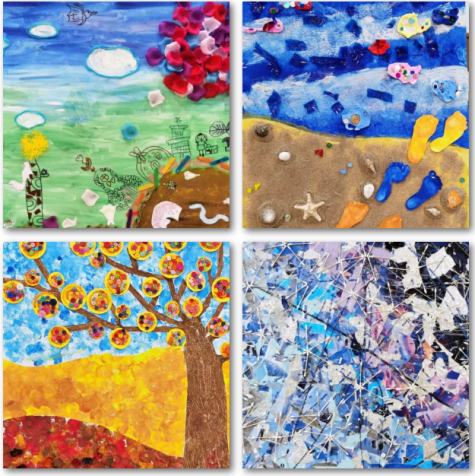
Our teachers preapared small canvases and various materials for pupils. In the meantime, they introduced different artists with varying representatvie stlyes, such as Yayoi Kusama, the princess of polka dots and a representative of pop art, who uses bright colours and dots to express her artistic thoughts; Eric Carle, illustrator of collage art, who uses collage to create his illustrations; and Dutch abstract painter Piet Mondrian, who adopted lines and three primary colours to paint.
Appreciating different artisitic styles enabled pupils to attempt to express themselves by utilising the formats that spoke to them artistically. Besides, their interactions with peers helped them to learn from each other and strengthened their bonds of friendship.
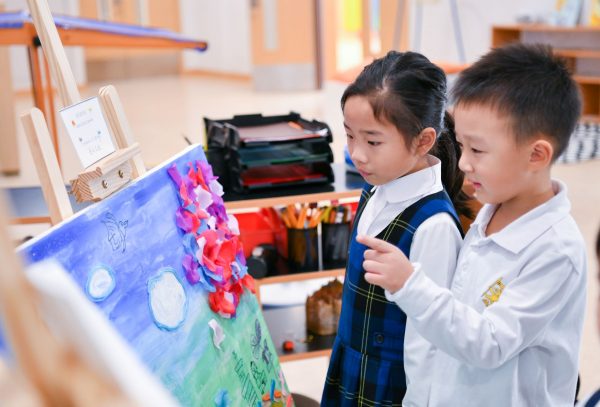
Research shows that introducing different artistic styles to young children can foster their aesthetic awareness as well as giving them enough opportunities to express themselves. Thus, in addition to finishing their own works, pupils also came together to complete the whole-class painting that mirrored their theme.
These paintings have been displayed in the corridor of each floor for anyone who passed them to appreciate. We also hope that this display reminds parents that they have a wonderful opportunity to take their children to galleries or art museums in support of the educational message of arts week.
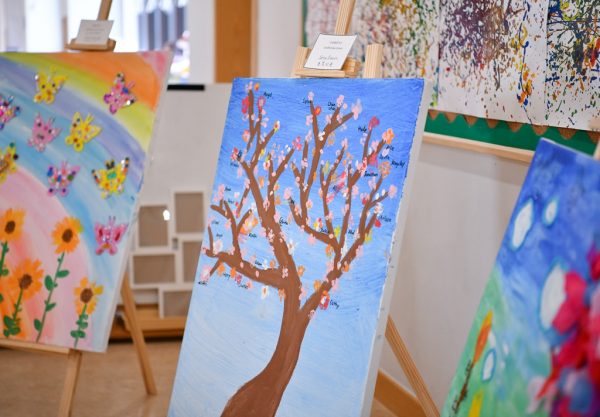
Forms of artistic expression are necessarily diverse. Besides painting, dance and music, were another two vital elements which could hardly be neglected during arts week.
Our music team teachers were honored to invite other classroom teachers and parents with diverse artistic talents to join in our arts week activites, who performed beautiful dance and played many splendid muscial instruments for pupils.
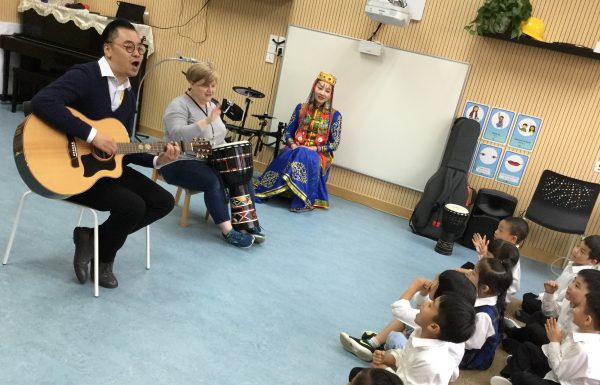
Our physical play teacher helped pupils put together rhythmic gymnastic displays that wonderfully resonated with the four seasons theme of our arts week.
What’s more, our whole-class paintings will be made into postcards to be sold at the Winter Market whilst the originals are auctioned to raise money for our charity cause, Da Hua in Guanxi province. What a treat for everyone to enjoy and for the wider community to benefit from!

 Childhood marks the initial development period of children’s artistic talent, when we can get twice the results with half the effort if we start with the right art education provision delivered in the right way.
Cultivates young children’s imagination, discernment and creativity
Artistic creation helps build children’s intuition, discernment and spatial imagination abilities, which complements their abstract logical thinking and contributes to their overall intelligence development.
Childhood marks the initial development period of children’s artistic talent, when we can get twice the results with half the effort if we start with the right art education provision delivered in the right way.
Cultivates young children’s imagination, discernment and creativity
Artistic creation helps build children’s intuition, discernment and spatial imagination abilities, which complements their abstract logical thinking and contributes to their overall intelligence development.
 It also drives them to imagine freely and boldly. Generally, we hardly set any limitations during their creative activities, as we intend to give them as much freedom as possible to utilise their imagination and innate creativity. Thus, children can represent whatever they visualise via different artistic media.
Develops young children’s personality
When children get involved in artistic creation, whether they use clay to make a model, a crayon to draw or recycled materials to create a collage, they will achieve a sense of personal satisfaction. This is because they are given the chance to choose their own materials and determine exactly how they wish their art to work. This process builds confidence and artistic flair.
When children participate in art activities together with their peers, they are able to communicate with each other and give their feedback while practising their social skills, such as sharing, negotiating and arranging.
Training young children’s hand-eye-brain coordination
In the process of artistic creation, young children’s fine and gross motor skills are developed, boosting their coordination and strength. By manipulating artistic tools and materials, flexibility and control of their motor skills are improved, aiding young children to develop their hand-eye coordination as well as enhancing their ability to use tools confidently.
Strengthen young children’s brain coordination
According to American scientist prof. Roger Sperry’s research, functions of cerebral hemispheres are highly specialised and each is independent yet interconnected with the other.
The right cerebral hemisphere dominates imaginal thinking tasks that are often used in artistic creation. To this end, art education helps to strengthen the brain’s coordination abilities while developing the potential of the right cerebral hemisphere.
Meanwhile, it also promotes the language function of the left cerebral hemisphere. Through artistic creation, various abilities of young children can be developed and that is why art education is critically important for cultivating the ‘whole child’.
Hiba Nursery Art Festival
During arts week, Hiba Academy Shanghai pupils took part in an interesting activity based on the theme of ‘four seasons’. Although pupils have had many daily opportunities to create art works, this was the first time that they joined in a whole-nursery art project.
It also drives them to imagine freely and boldly. Generally, we hardly set any limitations during their creative activities, as we intend to give them as much freedom as possible to utilise their imagination and innate creativity. Thus, children can represent whatever they visualise via different artistic media.
Develops young children’s personality
When children get involved in artistic creation, whether they use clay to make a model, a crayon to draw or recycled materials to create a collage, they will achieve a sense of personal satisfaction. This is because they are given the chance to choose their own materials and determine exactly how they wish their art to work. This process builds confidence and artistic flair.
When children participate in art activities together with their peers, they are able to communicate with each other and give their feedback while practising their social skills, such as sharing, negotiating and arranging.
Training young children’s hand-eye-brain coordination
In the process of artistic creation, young children’s fine and gross motor skills are developed, boosting their coordination and strength. By manipulating artistic tools and materials, flexibility and control of their motor skills are improved, aiding young children to develop their hand-eye coordination as well as enhancing their ability to use tools confidently.
Strengthen young children’s brain coordination
According to American scientist prof. Roger Sperry’s research, functions of cerebral hemispheres are highly specialised and each is independent yet interconnected with the other.
The right cerebral hemisphere dominates imaginal thinking tasks that are often used in artistic creation. To this end, art education helps to strengthen the brain’s coordination abilities while developing the potential of the right cerebral hemisphere.
Meanwhile, it also promotes the language function of the left cerebral hemisphere. Through artistic creation, various abilities of young children can be developed and that is why art education is critically important for cultivating the ‘whole child’.
Hiba Nursery Art Festival
During arts week, Hiba Academy Shanghai pupils took part in an interesting activity based on the theme of ‘four seasons’. Although pupils have had many daily opportunities to create art works, this was the first time that they joined in a whole-nursery art project.
 For young children, artistic creation is a sensory exploration activity. They like to paint on paper with different colours to see how a colour blend gets bigger and bigger. By exploring diverse materials, they can build their understanding of surrounding objects and their materials.
Each year group chose their corresponding season as their theme and early years 1 picked up summer, early years 2 autumn, early years 3 winter and early years 4 spring. Our teachers preapared small canvases and various materials for pupils.
For young children, artistic creation is a sensory exploration activity. They like to paint on paper with different colours to see how a colour blend gets bigger and bigger. By exploring diverse materials, they can build their understanding of surrounding objects and their materials.
Each year group chose their corresponding season as their theme and early years 1 picked up summer, early years 2 autumn, early years 3 winter and early years 4 spring. Our teachers preapared small canvases and various materials for pupils.
 Our teachers preapared small canvases and various materials for pupils. In the meantime, they introduced different artists with varying representatvie stlyes, such as Yayoi Kusama, the princess of polka dots and a representative of pop art, who uses bright colours and dots to express her artistic thoughts; Eric Carle, illustrator of collage art, who uses collage to create his illustrations; and Dutch abstract painter Piet Mondrian, who adopted lines and three primary colours to paint.
Appreciating different artisitic styles enabled pupils to attempt to express themselves by utilising the formats that spoke to them artistically. Besides, their interactions with peers helped them to learn from each other and strengthened their bonds of friendship.
Our teachers preapared small canvases and various materials for pupils. In the meantime, they introduced different artists with varying representatvie stlyes, such as Yayoi Kusama, the princess of polka dots and a representative of pop art, who uses bright colours and dots to express her artistic thoughts; Eric Carle, illustrator of collage art, who uses collage to create his illustrations; and Dutch abstract painter Piet Mondrian, who adopted lines and three primary colours to paint.
Appreciating different artisitic styles enabled pupils to attempt to express themselves by utilising the formats that spoke to them artistically. Besides, their interactions with peers helped them to learn from each other and strengthened their bonds of friendship.
 Research shows that introducing different artistic styles to young children can foster their aesthetic awareness as well as giving them enough opportunities to express themselves. Thus, in addition to finishing their own works, pupils also came together to complete the whole-class painting that mirrored their theme.
These paintings have been displayed in the corridor of each floor for anyone who passed them to appreciate. We also hope that this display reminds parents that they have a wonderful opportunity to take their children to galleries or art museums in support of the educational message of arts week.
Research shows that introducing different artistic styles to young children can foster their aesthetic awareness as well as giving them enough opportunities to express themselves. Thus, in addition to finishing their own works, pupils also came together to complete the whole-class painting that mirrored their theme.
These paintings have been displayed in the corridor of each floor for anyone who passed them to appreciate. We also hope that this display reminds parents that they have a wonderful opportunity to take their children to galleries or art museums in support of the educational message of arts week.
 Forms of artistic expression are necessarily diverse. Besides painting, dance and music, were another two vital elements which could hardly be neglected during arts week.
Our music team teachers were honored to invite other classroom teachers and parents with diverse artistic talents to join in our arts week activites, who performed beautiful dance and played many splendid muscial instruments for pupils.
Forms of artistic expression are necessarily diverse. Besides painting, dance and music, were another two vital elements which could hardly be neglected during arts week.
Our music team teachers were honored to invite other classroom teachers and parents with diverse artistic talents to join in our arts week activites, who performed beautiful dance and played many splendid muscial instruments for pupils.
 Our physical play teacher helped pupils put together rhythmic gymnastic displays that wonderfully resonated with the four seasons theme of our arts week.
What’s more, our whole-class paintings will be made into postcards to be sold at the Winter Market whilst the originals are auctioned to raise money for our charity cause, Da Hua in Guanxi province. What a treat for everyone to enjoy and for the wider community to benefit from!
Our physical play teacher helped pupils put together rhythmic gymnastic displays that wonderfully resonated with the four seasons theme of our arts week.
What’s more, our whole-class paintings will be made into postcards to be sold at the Winter Market whilst the originals are auctioned to raise money for our charity cause, Da Hua in Guanxi province. What a treat for everyone to enjoy and for the wider community to benefit from!